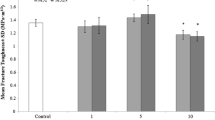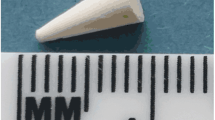Abstract
The stabilization of osteoporotic vertebrae with acrylic bone cement, called vertebroplasty, is a common procedure in modern surgery. However, the thermomechanical-chemically coupled material behaviour of curing bone cements makes the application even for experienced surgeons difficult and can lead to potential complications like heat necrosis, leaking bone cement, embolisms and postoperative load shifting. In order to reduce these potential complications, to minimize the risks and to better understand the occurring effects, the thermophysical properties of a commercial acrylic bone cement were investigated in detail using differential scanning calorimetry, volumetric dilatometry and temperature controlled rheometry. More specifically, the reaction kinetics, the specific heat, the thermal conductivity, the thermal expansion, the chemical shrinkage as well as the mechanical behaviour was studied during the reaction process of the bone cement. Furthermore, the explored material behaviour is described by a customized material model that takes into account all observed effects. With the aid of this model the inhomogeneous chemical, thermal and mechanical states that appear during the application and curing of acrylic bone cements, can be studied by finite element treatment.




















Similar content being viewed by others
References
Mazzullo S, Paolini M, Verdi C. Numerical simulation of thermal bone necrosis during cementation of femoral prostheses. J Math Biol. 1991;29:475–94.
Maffezzoli A, Ronca D, Guida G, Pochini I, Nicolais L. In-situ polymerization behaviour of bone cements. J Mater Sci Mater Med. 1997;8:75–83.
Lingois P, Berglund L, Maffezzoli A. Chemically induced residual stresses in dental composites. J Mater Sci. 2003;38:1321–31.
Briscoe A, New A. Polymerisation stress modelling in acrylic bone cement. J Biomech. 2010;43:978–83.
Perez MA, Nuno N, Madrala A, Garcia-Aznar JM, Doblare M. Computational modelling of bone cement polymerization: temperature and residual stresses. Comput Biol Med. 2009;39:751–9.
Beaudoin AJ, Mihalko WM, Krause WR. Finite element modelling of polymethylmethacrylate flow through cancellous bone. J Biomech. 1991;24(2):127–36.
Baroud G, Yahia FB. A finite element rheological model for polymethylmethacrylate flow: analysis of the cement delivery in vertebroplasty. J Eng Med. 2004;218:331–8.
Baroud G, Bohner M, Heini PF, Steffen T. Injection of biomechanics of bone cements used in vertebroplasty. Biomed Mater Eng. 2004;14:487–504.
Baroud G, Vant C, Giannitsios D, Bohner M, Steffen T. Effect of vertebral shell on injection pressure and intravertebral pressure in vertebroplasty. Spine. 2004;30:68–74.
Baroud G, Crookshank M, Bohner M. High-viscosity cement significantly enhances uniformity of cement filling in vertebroplasty: an experimental model and study on cement leakage. Spine. 2004;31:2562–8.
Srimongkol S, Wiwatanapataphee B, Wu YH. Computer simulation of polymethylacrylate bone cement flow through femoral canal and cancellous bone. Aust New Zealand Ind Appl Math J. 2005;47:C404–18.
Choon Meng JT. Patient specific finite volume modeling for intraosseous PMMA cement flow simulation in vertebral cancellous bone. PhD thesis, National University of Singapore. 2007.
Baroud G, Nemes J, Heini PF, Steffen T. Load shift of the intervertebral disc after a vertebroplasty: a finite element study. Eur Spine J. 2004;12:421–6.
Rohlmann A, Zander T, Jony WU, Weber U, Bergmann G. Einfluss der Wirbelkrpersteifigkeit auf den intradiskalen druck. Biomed Tech. 2005;50:148–52.
Lion A, Yagimli B, Baroud G, Görke U. Constitutive modelling of PMMAbased bone cement: a functional model of viscoelasticity and its approximation for time domain investigations. Arch Mech. 2008;60:221–42.
Lion A, Höfer P. On the phenomenological representation of curing phenomena in continuum mechanics. Arch Mech. 2007;59:59–89.
Drebushchak VA. From electrical analog to thermophysical modeling of DSC. J Therm Anal Calorim. 2010. doi:10.1007/s1097301012003.
Schawe JEK. A description of chemical and diffusion control in isothermal kinetics of cure kinetics. Thermochim Acta. 2002;388:299–312.
Blumenstock T. Analyse der Eigenspannungen während der Aushärtung von Epoxidharzmassen. PhD thesis, Universität Stuttgart. 2003.
Wenzel M. Spannungsbildung und Relaxationsverhalten bei der Aushärtung von Epoxidharzen. Technische Universität Darmstadt. 2005.
Kolmeder S, Lion A. On the thermomechanical-chemically coupled behavior of acrylic bone cements: experimental characterization of material behavior and modeling approach. Tech Mech. 2010;30:195–202.
O’Neill MJ. Measurement of specific heat functions by differential scanning calorimetry. Anal Chem. 1996;38:1331–6.
Van Assche G, Van Hemelrijck A, Rahier H, Van Mele B. Modulated differential scanning calorimetry: isothermal cure and vitrification of thermosetting systems. Thermochim Acta. 2004;268:121–42.
Lion A, Yagimli B. Differential scanning calorimetry—continuum mechanical considerations with focus to the polymerisation of adhesives. Z Angew Math Mech. 2008;88:388–402.
Shanks RA, Gunaratne LMWK. Comparison of reversible melting behaviour of poly(3-hydroxybutyrate) using quasi-isothermal and other modulated temperature differential scanning calorimetry techniques. J Therm Anal Calorim. 2011. doi:10.1007/s1097301112835.
Gracia-Fernández C, Tarró-Saavedra J, López-Beceiro J, Gómez-Barreiro S, Naya S, Artiaga R. Temperature modulation in PDSC for monitoring the curing under pressure. J Therm Anal Calorim. 2011. doi:10.1007/s1097301113618.
Sato Y, Taira T. The studies of thermal conductivity in GdVO4, YVO4, and Y3Al5O12 measured by quasi-onedimensional flash method. Opt Exp. 2006;14:10528–36.
Moynihan CT, Easteal AJ, Wilder J, Tucker J. Dependence of the glass transition temperature on heating and cooling rate. J Phys Chem 1974;78:2673–7.
Risen R, Schawe JKE. Die Glasübergangstemperatur gemessen mit verschiedenen TA Techniken. Teil 1: Übersicht. UserCom. 2003;17:1–4.
Risen R, Schawe JKE. Die Glasübergangstemperatur gemessen mit verschiedenen TA Techniken, Teil 2: ermittlung der glasübergangstemperatur. UserCom. 2003;18:1–5.
Lion A, Liebl C, Kolmeder S, Peters J. Representation of the glass-transition in mechanical and thermal properties of glass-forming materials: a three-dimensional theory based on thermodynamics with internal state variables. J Mech Phys Solids. 2010;58:1338–60.
Barbés B, Páramo R, Sobrón F, Blanco E, Casanova C. Thermal conductivity measurement of liquids by means of a microcalorimeter. J Therm Anal Calorim. 2010. doi:10.1007/s109730101169y.
Tian F, Sun L, Mojumdar SC, Venart JES, Prasad RC. Absolute measurement of thermal conductivity of poly (acrylic acid) by transient hot wire technique. J Therm Anal Calorim. 2011. doi:10.1007/s1097301012613.
Maffezzoli A, Terzi R. Thermal analysis of visible light-activated dental composites. Thermochim Acta. 1995;269/270:319–35.
Micelli F, Maffezzoli A. Characterization of the kinetic behavior of resin modified Glass-ionomer cements by DSC, TMA and ultrasonic wave propagation. J Mater Sci Mater Med. 2001;12:151–6.
Farrar DF, Rose J. Rheological properties of PMMA bone cements during curing. Biomater. 2001;22:3005–13.
O’Brien DJ, Mather PT, White SR. Viscoelastic properties of an epoxy resin during cure. J Compos Mater. 2001;35:883–904.
Collyer AA, Clegg DW. Rheological measurement. New York: Elsevier Applied Science; 1988.
Kamal MR, Sourour S, Ryan M. Kinetic and thermal characterization of thermoset cure. Polym Eng Sci. 1973;13:59–64.
Sourour S, Kamal MR. Differential scanning calorimetry of epoxy-amine cure: isothermal cure kinetics. Thermochim Acta. 1976;14:41–59.
Kenny JM, Maffezzoli A, Nicolais L. A Model for the thermal and chemorheological behavior of thermoset processing: (II) unsaturated polyester based composites. Compos Sci Technol.1990; 38:339–58.
Maffezzoli A. Polymerisation kinetics of acrylic bone cements by differential scanning calorimetry. J Therm Anal. 1996;47:35–49.
Fournier J, Williams G, Duch C, Aldridge GA. Changes in molecular dynamics during bulk polymerization of an epoxide-amine system as studied by dielectric relaxation spectroscopy. Macromol. 1996;29:7079–107.
Haupt P. Continuum mechanics and theory of materials, 2nd edn. Berlin: Springer; 2002.
Holzapfel GA. Nonlinear solid mechanics: a continuum approach for engineering. Chichester: Wiley; 2000.
Böhme G. Strömungsmechanik nichtnewtonscher Fluide, 2nd edn. Stuttgart: Teubner Verlag; 2000.
Alberty RA. Use of legendre transforms in chemical thermodynamics. Pure Appl Chem. 2001;73(8):1349–80.
Höfer P. Dynamische Eigenschaften technischer Gummiwerkstoffe: experimente, thermomechanische materialmodellierung und implementierung in die FEM. München: Verlag Dr. Hut; 2009.
Haupt P, Lion A. On finite linear viscoelasticity of incompressible isotropic materials. Acta Mech. 2002;159:87–124.
Lion A, Kardelky C. The payne effect in finite viscoelasticity: constitutive modelling based on fractional derivatives and intrinsic time scales. Int J Plast. 2004;20:1313–45.
Acknowledgements
The authors would like to thank the German Research Foundation DFG for support of this study.
Author information
Authors and Affiliations
Corresponding author
Rights and permissions
About this article
Cite this article
Kolmeder, S., Lion, A., Landgraf, R. et al. Thermophysical properties and material modelling of acrylic bone cements used in vertebroplasty. J Therm Anal Calorim 105, 705–718 (2011). https://doi.org/10.1007/s10973-011-1508-7
Published:
Issue Date:
DOI: https://doi.org/10.1007/s10973-011-1508-7




